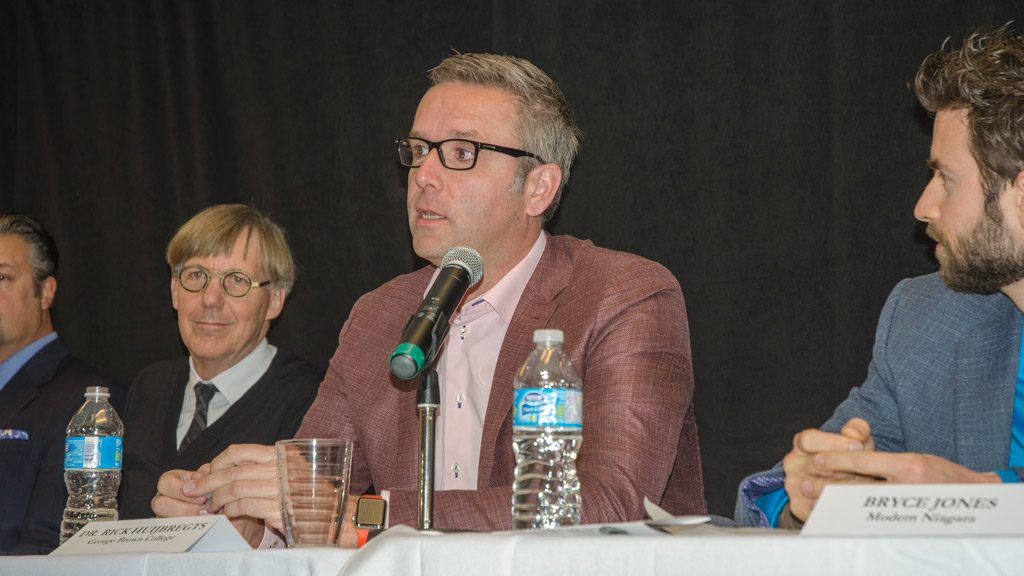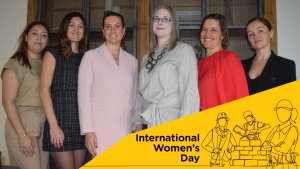Construction has been one of the slowest industries to adopt new technology and if companies don’t develop innovative strategies to stay ahead, they will be left behind, a panel of experts highlighted during the Toronto Construction Association’s 24th annual Members’ Day.
“Right now the entire market is ripe for change and there are opportunities and ideas out there,” said Terry Olynyk, director of business development with PCL Constructors Canada Inc., who was part of an industry forum on innovation and new technology during the Richmond Hill, Ont. event May 9.
“I am challenging you to think about five years from now. What are you as an organization going to look like, what do you want to look like, do you have that vision? How are you scanning the horizon to understand where you fit in this world of change and technology? A lot of people know that there is technology out there, but what small steps are you taking now to be in the game? That’s what I would like to encourage the room to do — find a couple of valuable opportunities.”
Rick Huijbregts, vice-president of strategy and innovation with George Brown College, said most of the jobs that exist today will not exist in the future.
“They are making predictions on what those jobs are and none of them are in construction, they’re all in data, analytics, intelligence, drones,” explained Huijbregts. “How do we, as an industry, capture this moment and actually leapfrog and get ahead? Collaborate, innovate and educate.
“I think there is a big opportunity for us as a college and you, as an industry, to work together to accelerate the transformation that you badly need.”
He encouraged industry and associations to work with the college on a few different fronts.
“We are going to get a whole whack of new students that are graduating and looking for a new job,” Huijbregts noted. “How do you make sure that the jobs you have are sexy enough? How do you make sure that you partner with us or institutions like us to ensure that what they are learning today is relevant to you tomorrow?”
He added, “I think the colleges are very well positioned to be your arms-length R&D department. We can de-risk for you the experimentation and the testing of new innovations and new technology by collaborating. There is lots of government funding available to help you do exactly that.”
Olynyk pointed out that PCL was doing things the same way for over 100 years but realized change was needed. They built a modular construction facility where they prefabricate portions of projects offsite. This also helps with the issues surrounding the skills shortage, he explained.
“More and more elements are going to get built in the factory and that is going to take pressure off of our critical path on our projects,” said Olynyk.
“If you can start to automate and you can build in a factory, there are so many benefits…take all those hours off of the job. You have made the job less congested, less pressure, less deficiencies and ultimately safer. When you’ve built something in the factory you’ve given yourself certainty.”
Companies are also starting to experiment with the Internet of Things by installing sensors on equipment to measure data.
“I guarantee you you’ll become addicted,” said Olynyk. “The more and more data you start to gain, the more insight it will give you and the more you’re going to want and then you’re in the game. Once you’re in that game you’re going to start to monitor and understand it and be a lot more in tune with what it means.”
In addition to new technology, new methodologies also help companies stay ahead, explained Bryce Jones, construction manager with Modern Niagara.
“The Integrated Project Delivery (IPD) world has gained some traction in trying to make a much more collaborative nature and build much more of a relationship and trust,” said Jones. “In the construction industry, the trust part is kind of broken. IPD tries to put this mutually beneficial end goal by aligning everyone.”
Jones also shared his experience with virtual reality and other innovative software as a way to visualize what a building will look like before it is constructed and possibly finding issues before the construction process begins.
“That is also going to start attracting some of the younger workforce to say what you guys are doing is actually pretty cool and I want to be part of it,” said Jones.
The construction industry has always been risk averse when it comes to adopting new technology and innovation, John Mollenhauer, president and CEO of the TCA, told the Daily Commercial News following the discussion.
“For most in the audience the takeaway is ‘wow, we better go back to our office and begin to think strategically, talk about some of these things that may make sense for us and what would happen if we don’t,’ ” said Mollenhauer. “I think we’re now beginning as an industry to realize we actually have to take the next step, we have to adapt and adopt new technologies and respond to this change…What we know for certain is that we can’t afford not to embrace these technologies.”








Recent Comments
comments for this post are closed